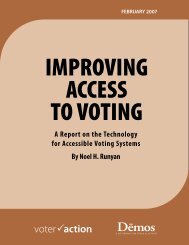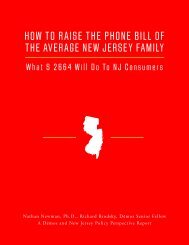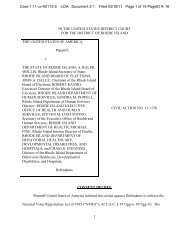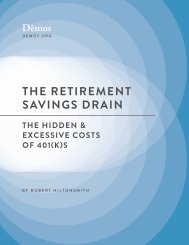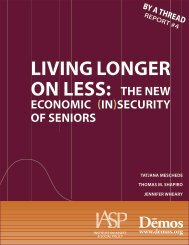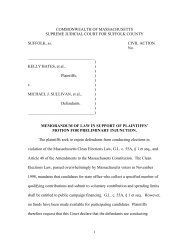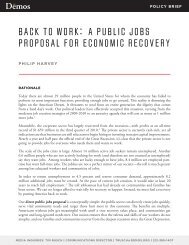JP Morgan Chase Whale Trades: A Case History of ... - Demos
JP Morgan Chase Whale Trades: A Case History of ... - Demos
JP Morgan Chase Whale Trades: A Case History of ... - Demos
You also want an ePaper? Increase the reach of your titles
YUMPU automatically turns print PDFs into web optimized ePapers that Google loves.
<strong>JP</strong> <strong>Morgan</strong> <strong>Chase</strong> <strong>Whale</strong> <strong>Trades</strong>: A <strong>Case</strong> <strong>History</strong> <strong>of</strong> Derivatives Risks and Abuses<br />
United States Senate Permanent Subcommittee on Investigations Hearing and Report<br />
Brief Synopsis<br />
Wallace C. Turbeville, <strong>Demos</strong> Senior Fellow<br />
On March 15, 2012, the Senate’s Permanent Subcommittee on Investigations held hearings on<br />
the London <strong>Whale</strong> scandal. The indomitable and indefatigable Chairman Carl Levin, ably<br />
supported by the brilliant committee chief <strong>of</strong> staff, Elise Bean, took on six <strong>JP</strong> <strong>Morgan</strong> <strong>Chase</strong><br />
(“<strong>JP</strong>MC”) current and former executives for four hours and three regulators for two, with<br />
support from other Committee members. The Senator used the information from the 300-‐page<br />
committee report masterfully to illicit information on the massive losses incurred by <strong>JP</strong>MC’s<br />
London branch on a trading strategy involving $157 billion notional amount <strong>of</strong> credit derivatives<br />
tied to the default risk <strong>of</strong> corporations in Europe and the US.<br />
This hearing and the accompanying report reveal specific misdeeds and the chilling fallibility <strong>of</strong><br />
risk systems that could plunge the word into economic ruin. They also provide insights into Wall<br />
Street culture and its operational realities. The consequences <strong>of</strong> the hearing and report are<br />
potentially enormous, changing public discourse on controlling the mega-‐banks, who see<br />
themselves as a law unto themselves, governed by greed and hubris worthy <strong>of</strong> Greek tragedy.<br />
The London <strong>Whale</strong> trades could not have brought <strong>JP</strong>MC down; the losses, $6.2 billion, were too<br />
small given the size <strong>of</strong> <strong>JP</strong>MC. But the risky behavior, incompetence, lawlessness and arrogance<br />
very well could some day.<br />
There are several broad areas <strong>of</strong> misconduct covered by the PSI: disclosure and regulatory<br />
reporting are two. These grow out <strong>of</strong> the other broad area: the preference for manipulation <strong>of</strong><br />
analytics to obscure reality losses and risks growing out <strong>of</strong> unrestrained trading behavior. The<br />
following is a synopsis <strong>of</strong> these topics together with an analysis <strong>of</strong> the implications <strong>of</strong> the<br />
hearing and report.<br />
Manipulation <strong>of</strong> Analytics<br />
By the end <strong>of</strong> 2011, the department <strong>of</strong> <strong>JP</strong>MC known as the Chief Investment Office (“CIO”),<br />
whose task was to reduce risk in the global organization, held a portfolio <strong>of</strong> indexed credit<br />
default swaps with a notional amount <strong>of</strong> $51 billion (the “Synthetic Credit Portfolio” or “SCP”).<br />
CONNECT WITH DĒMOS AT: WWW.DEMOS.ORG<br />
FOLLOW US AT: @DEMOS_ORG<br />
FACEBOOK.COM/DEMOSIDEASACTION<br />
KEEP ON TOP OF THE LATEST TRENDS AND ANALYSIS<br />
FROM DĒMOS AT OUR NEW BLOG, POLICYSHOP.NET<br />
MEDIA CONTACT<br />
Lauren Strayer<br />
lstrayer@demos.org<br />
(212) 389-1413
Consistent with CIO’s mission, the SCP was denoted a “hedge,” or <strong>of</strong>fset to risks <strong>of</strong> <strong>JP</strong>MC’s<br />
business. The business risks hedged were obscure, however. They were described as the risk <strong>of</strong><br />
companies around the world going bankrupt. The SCP had, in reality, become a complex set <strong>of</strong><br />
transactions that seemed not to hedge anything in particular. Risk mitigation had increasingly<br />
become secondary to trading for pr<strong>of</strong>it over a three-‐year period in which the SCP had grown<br />
ten-‐fold in notional amount. The witnesses confirmed that, regardless <strong>of</strong> the initial intent, the<br />
SCP was a massive risk position designed to make (or lose) large sums <strong>of</strong> money.<br />
This very fact was in fact a manipulative deception. The CIO was designed to invest excess<br />
deposits (i.e., deposited funds that had not been loaned) in safe securities and to enter into<br />
hedges that would <strong>of</strong>fset bank risks. This deflected the attention <strong>of</strong> regulators from the CIO<br />
who ascribed a low priority to red flags associated with the CIO that could have attracted<br />
inquiry. Based on appearances, there were other areas <strong>of</strong> the bank that were far more<br />
susceptible to dangerous losses.<br />
By early 2012, the SCP had created two separate problems for the CIO. First, it simply started to<br />
yield losses rather than pr<strong>of</strong>its and the losses were large. Second, the internal risk management<br />
calculation <strong>of</strong> forward-‐looking risk meant that, under the soon-‐to-‐be implemented international<br />
Basel 2.5 rules, the SCP would force <strong>JP</strong>MC to set aside large amounts <strong>of</strong> capital to <strong>of</strong>fset its<br />
risks. This was the result under Basel 2.5’s risk weighted capital rules, or “RWA.” Instead <strong>of</strong><br />
winding down the SCP, the CIO and other parts <strong>of</strong> the bank set out to solve these two problems<br />
in extremely dubious ways.<br />
The cumulative market gains or losses were determined by comparing current market prices <strong>of</strong><br />
the SCP positions with their acquisition costs. This is referred to as “marking to market.” Market<br />
prices are really the prices to buy and sell that are quoted on the markets. The spread between<br />
the two is the “bid/ask” spread. <strong>JP</strong>MC, and most financial institutions, had commonly used the<br />
midpoint between the bid and ask prices to mark their holdings to market.<br />
In January, the CIO traders abandoned that practice and started using prices closer to bid or<br />
ask, the boundaries <strong>of</strong> the bid/ask spread. Uniformly, they picked prices at the border <strong>of</strong> the<br />
bid/ask spread that lowered the measured losses in the SCP compared with marks based on the<br />
midpoint prices. The effect on the understatement <strong>of</strong> losses was not cumulative. For example,<br />
assume a position acquired a 7. If the current midpoint price is 5 and the manipulated price is 6<br />
on day one, the mark would be the difference between 7 and 6 rather than 7 and the midpoint,<br />
or 5. The misstatement <strong>of</strong> cumulative loss is 1. On the next day, if the midpoint price is 4 and<br />
2
the manipulated price is 5, the cumulative loss would be measured at 2 rather than 3, still a<br />
cumulative misstatement <strong>of</strong> 1. Of course the cumulative loss would be misstated every day, but<br />
never more than the current difference between the midpoint and the highest price within the<br />
bid/ask spread. It was a manipulation that did not get substantially worse quantitatively each<br />
day, but was persistent over a period <strong>of</strong> months.<br />
As has become familiar in investigations <strong>of</strong> financial institutions, e-‐mails told the story. The CIO<br />
traders who applied the marks called them “idiotic” and openly discussed what they were<br />
doing. Later in the first quarter, senior bank management defended the marks internally as<br />
within GAAP accounting rules, which is <strong>of</strong> course beside the point. Senator Levin successfully<br />
forced the bank witnesses to agree that manipulating mark-‐to-‐market practices for the purpose<br />
<strong>of</strong> hiding losses in a portfolio is unacceptable, even if it were in accordance with GAAP, an<br />
assumption that he did not agree with.<br />
In bilateral derivatives transactions, margin collateral is <strong>of</strong>ten posted based on marks that are<br />
to be agreed to by the two counterparties. That was the case with the SCP. The marks used by<br />
the CIO traders for SCP precipitated serious disputes with counterparties starting in March. The<br />
amounts disputed peaked in mid-‐April at $690 million. These disputes, which were a clear<br />
indication <strong>of</strong> problems with marks, came to the attention <strong>of</strong> senior bank <strong>of</strong>ficials and the<br />
regulators in April, after news accounts had revealed the issues associated with the SCP.<br />
Notwithstanding losses as early as January 2012, the CIO doubled and tripled down on the SCP<br />
positions. The SCP grew to $157 billion in notional amount by the end <strong>of</strong> the first quarter, even<br />
though the CIS had told regulators in January that it intended to reduce its size over 2012. The<br />
traders were literally out <strong>of</strong> control. As the SCP got bigger and the indexed credit derivatives<br />
market was showing signs <strong>of</strong> stress, in large part because <strong>of</strong> CIS’s buying spree, the forward-‐<br />
looking measurement <strong>of</strong> risk associated with SCP deteriorated badly. This set <strong>of</strong>f alarms within<br />
<strong>JP</strong>MC, because risk limits were being exceeded and the RWA Basel 2.5 calculations were<br />
requiring more capital to be taken out <strong>of</strong> circulation.<br />
The primary (but not exclusive) problem for CIO was two variations <strong>of</strong> Value at Risk, a statistical<br />
estimate <strong>of</strong> how much the bank might lose in SCP in one day <strong>of</strong> trading based on historic<br />
experience. One variation looked at “normal” market conditions and the other looked at<br />
“stressed” market conditions. Limits were exceeded for both (as well as for other, less critical<br />
metrics).<br />
3
<strong>JP</strong>MC addressed the breeches <strong>of</strong> VaR limits by temporarily increasing the limits, an act that CEO<br />
Jamie Dimon approved. This was intended as a stopgap until the VaR mode could be changed.<br />
The CIO had been constructing a new VaR model that would lower calculated risk in the SCP. It<br />
had not yet been properly tested and there was no system in place to transmit data on new<br />
trades automatically. New trades would have to be manually recorded on a spreadsheet and<br />
then loaded each night, a cumbersome process fraught with the potential for human error.<br />
Nonetheless, CIO put the new VaR model in place at the end <strong>of</strong> January. The apparent risk <strong>of</strong><br />
the SCP dropped by 50% instantaneously, well below limits. Nothing had changed, but the<br />
flashing red lights were turned <strong>of</strong>f. And the original risk limits were reinstated, not new more<br />
stringent limits appropriate to the new model’s built-‐in lower risk calculations.<br />
It would be reasonable to anticipate that CIO would cut its losses and reduce the SCP in an<br />
orderly fashion. But instead, the traders used the new risk headroom to lay on more trades,<br />
increasing the SCP notional amount to $157billion by the time the “phones down” order came<br />
from management at the end <strong>of</strong> the first quarter stopping all trading in the SCP. In the interim,<br />
the manual data inputs had, predictably, created a corrupted data set that added to the<br />
problems <strong>of</strong> the new model. The old VaR model was reinstated in May, after press reports had<br />
made the London <strong>Whale</strong> trades public and billions had been lost.<br />
Misleading Regulators<br />
<strong>JP</strong>MC’s principal prudential regulator, the Office <strong>of</strong> the Comptroller <strong>of</strong> the Currency (“OCC”)<br />
first learned <strong>of</strong> the massive SCP position from the initial press reports <strong>of</strong> the London <strong>Whale</strong> on<br />
April 6. This is particularly concerning given the size <strong>of</strong> the risk associated with the SCP and the<br />
fact that the OCC has 65 onsite examiners dedicated to <strong>JP</strong>MC.<br />
Within days <strong>of</strong> becoming aware <strong>of</strong> the SCP through the press, the OCC determined that the SCP<br />
was not actually a hedge, but was in fact a massive risk position designed with the intent to<br />
generate trading pr<strong>of</strong>its. After May 4, the OCC met with <strong>JP</strong>MC daily regarding the SCP. But, by<br />
then the bank had already lost at least $2.3 billion on the positions. (Note that the OCC claims<br />
that CFO Douglas Braunstein said on May 4 that the losses were $1.6 billion, but Braunstein<br />
claims that the $1.6 billion number was identified as the losses since the start <strong>of</strong> the 2 nd quarter<br />
on April 1.)<br />
Prior to that time, the OCC was aware that the CIO had breached the risk management limits<br />
according to several criteria. Of course, the VaR related criteria were changed to eliminate<br />
4
critical breaches, but breaches under other, perhaps less critical, criteria persisted. A clear<br />
opportunity to influence the outcome had been lost and the SCP grew immensely after the<br />
initial breaches.<br />
The OCC was unaware <strong>of</strong> the changed mark-‐to-‐market procedures until May when it was<br />
informed <strong>of</strong> the counterparty collateral disputes and enquired further.<br />
The OCC regulators explain that they failed to pursue warning signs promptly largely because<br />
the activities <strong>of</strong> the CIO were thought to be a low priority in terms <strong>of</strong> potential risk. They had no<br />
idea <strong>of</strong> the size <strong>of</strong> the SCP. And the OCC assumed that the CIO activities were in accord with its<br />
stated mission, investment <strong>of</strong> excess deposits and risk-‐reducing hedging. This does not explain<br />
why the OCC was so unaware <strong>of</strong> CIO activity.<br />
The OCC asserts that <strong>JP</strong>MC, like all large banks, is expected to affirmatively inform the OCC <strong>of</strong><br />
significant events, such as the size <strong>of</strong> the SCP, the losses, the occurrence <strong>of</strong> the risk limit<br />
breaches and the changes to the VaR models. That did not occur. This failure is consistent with<br />
a pattern <strong>of</strong> activity at <strong>JP</strong>MC.<br />
The PSI report and hearing depict a very different relationship between <strong>JP</strong>MC and its principal<br />
regulator than that described by OCC as appropriate. In 2010, the OCC issued a Supervisory<br />
Letter directing improvement <strong>of</strong> CIO’s portfolio decisions and risk management. The head <strong>of</strong><br />
CIO and Operating Committee member, Ina Drew, strenuously resisted the admonition in a<br />
meeting, claiming that the OCC was trying to “destroy” <strong>JP</strong>MC’s business and reportedly<br />
asserting that “that investment decisions are made with the full understanding <strong>of</strong> executive<br />
management, including Jamie Dimon.”<br />
Another example put forth by PSI involved the abrupt and unexplained cessation <strong>of</strong> daily P&L<br />
reports concerning <strong>JP</strong>MC’s investment bank in February 2012. Testimony states that CEO Jamie<br />
Dimon ordered this cessation because he believed P&L information had leaked, though there<br />
was no evidence that the OCC was the source <strong>of</strong> the leak. The OCC eventually complained to<br />
the then-‐CFO Douglas Braunstein who reinstated them weeks after the cessation, an act that<br />
angered <strong>of</strong> Mr. DImon. Senator McCain remarked on Jamie Dimon’s decision, musing whether<br />
there was any other company in America that would, in an unfounded fit <strong>of</strong> pique, stiff its<br />
principal regulator on required reports and expect to get away with it.<br />
5
Other antagonistic meetings were recounted. What emerges is an adversarial attitude <strong>of</strong> <strong>JP</strong>MC<br />
executives toward the OCC resulting in an adversarial relationship that is simply inappropriate.<br />
It must be pointed out that the current Comptroller <strong>of</strong> the Currency was not confirmed and<br />
sworn in until April 2012, replacing an Acting Comptroller who had been in charge <strong>of</strong> OCC for<br />
more than 1 ½ years. Curry came to the OCC amidst reports <strong>of</strong> the agencies longstanding lax<br />
attitude toward bank regulation. The hearing and report indicate that the Commissioner needs<br />
to make changes.<br />
Misleading the Public<br />
<strong>JP</strong>MC disclosed nothing publicly about SCP prior to news stories on April 6. Clearly, widespread<br />
knowledge <strong>of</strong> the situation could have made management or liquidation <strong>of</strong> the SCP more<br />
difficult.<br />
As stated in the report, on April 10, as internal estimates <strong>of</strong> the loss had reached $415 million,<br />
“[t]he bank’s communications <strong>of</strong>ficer and chief investment liaison circulated talking points and,<br />
that same day, April 10, met with reporters and analysts to deliver reassuring messages about<br />
the SCP. Their primary objectives were to communicate, among other matters, that the CIO’s<br />
activities were ‘for hedging purposes’ and that the regulators were ‘fully aware,’ <strong>of</strong> its activities,<br />
neither <strong>of</strong> which was true.”<br />
<strong>JP</strong>MC followed these messages up on April 13 by filing an 8-‐Q report with the SEC and hosting<br />
an earnings call featuring CEO Jamie Dimon and then-‐CFO Douglas Braunstein. DImon referred<br />
to the media reports as a “tempest in a teapot.” Braunstein made several remarks that the PSI<br />
considered concerning, as demonstrated by the following quoted text from the report:<br />
• “Mr. Braunstein stated on the April 13 earnings call that ‘all <strong>of</strong> those positions are put<br />
on pursuant to the risk management at the firm-‐wide level.’ The evidence indicates,<br />
however, that in 2012, <strong>JP</strong><strong>Morgan</strong> <strong>Chase</strong>’s firmwide risk managers knew little about the<br />
SCP and had no role in putting on its positions.”<br />
• “Mr. Braunstein said that the SCP positions were ‘fully transparent to the regulators,’<br />
who ‘get information on those positions on a regular and recurring basis as part <strong>of</strong> our<br />
normalized reporting.’ In fact, the SCP positions had never been disclosed to the OCC in<br />
any regular bank report. The bank had described the SCP’s positions to the OCC for the<br />
first time, in a general way, only a few days earlier and failed to provide more detailed<br />
information for more than a month.”<br />
6
• “Mr. Braunstein also stated that with regard to ‘managing’ the stress loss positions <strong>of</strong><br />
the Synthetic Credit Portfolio, ‘[a]ll <strong>of</strong> the decisions are made on a very long-‐term basis.’<br />
In fact, the CIO credit traders engaged in daily derivatives trading, and the bank<br />
conceded the SCP was ‘actively traded.’ An internal CIO presentation in March 2012,<br />
provided to the bank’s executive committee a month before the earnings call, indicated<br />
that the SCP operated on a ‘short’ time horizon. In addition, many <strong>of</strong> the positions<br />
producing SCP losses had been acquired just weeks or months earlier. Mr. Braunstein’s<br />
characterization <strong>of</strong> the SCP as making long term investment decisions was contrary to<br />
both the short-‐term posture <strong>of</strong> the SCP, as well as how it actually operated in 2011 and<br />
2012. His description was inaccurate at best and deceptive at worst.<br />
• “Mr. Braunstein indicated that the SCP was intended to provide ‘stress loss protection’<br />
to the bank in the event <strong>of</strong> a credit crisis, essentially presenting the SCP as a portfolio<br />
designed to lower rather than increase bank risk. But in early April, days before the<br />
earnings call, Ms. Drew told the bank’s executive committee that, overall, the SCP was<br />
‘long’ credit, a posture that multiple senior executives told the Subcommittee was<br />
inconsistent with providing protection against a credit crisis.”<br />
• “[Mr. Braunstein said:] ‘[W]e believe all <strong>of</strong> this is consistent with what we believe the<br />
ultimate outcome will be related to Volcker.’ The Volcker Rule is intended to reduce<br />
bank risk by prohibiting high risk proprietary trading activities by federally insured<br />
banks, their affiliates, and subsidiaries. However, the Volcker Rule also allows certain<br />
trading activities to continue, including ‘risk-‐mitigating hedging activities.’ Mr.<br />
Braunstein’s statement gave the misimpression that the SCP was ‘hedging’ risk.”<br />
The PSI also expressed concerns about the omission <strong>of</strong> disclosure about changes to the VaR<br />
model until after the old VaR model was reinstated. This was particularly concerning because<br />
the April 13 8-‐Q reported a first quarter CIO VaR figure that was comparable to the prior<br />
reported CIO VaR figure for the last quarter in 2011 without stating that the VaR model had<br />
been changed in the interim. The PSI was also concerned with the characterizations <strong>of</strong> the<br />
reasons for reinstating the old VaR model when it was discussed in a May 10 call with investors<br />
and analysts in connection with the filing <strong>of</strong> the banks annual 10-‐K report with the SEC.<br />
7
Implications <strong>of</strong> the PSI Hearing and Report<br />
The issues that have been raised have many implications for policies and regulations that are<br />
currently being deliberated in the United States and abroad.<br />
The Volcker Rule<br />
The Volcker Rule generally prohibits insured banks from engaging in proprietary trading, or<br />
trading activities that put their balance sheets at risk. Proposed regulations have been issued<br />
and final regulations are being prepared.<br />
The statute excepts the following activity from the proprietary trading ban:<br />
Risk-‐mitigating hedging activities in connection with and related to individual or<br />
aggregated positions, contracts, or other holdings <strong>of</strong> a banking entity that are designed<br />
to reduce the specific risks to the banking entity in connection with and related to such<br />
positions, contracts, or other holdings.<br />
The proposed rules contain language that appears to interpret this provision narrowly and<br />
other language that is broader. This requires reconciliation in the final rule.<br />
<strong>JP</strong>MC asserted that the SCP was originally a hedge that morphed into a proprietary position and<br />
that the hedge would have qualified under the Volcker Rule. The risk that was “hedged”<br />
appears to have been a general amorphous risk from corporate defaults. Was this risk related<br />
to “individual or aggregated positions, contracts or other holdings?” Furthermore, was it<br />
designed to “reduce the specific risks?” Critics <strong>of</strong> the Volcker Rule assert that positions like the<br />
SCP, justified as <strong>of</strong>fsetting some ill-‐defined risks, should be permitted. The PSI hearing and<br />
report provide persuasive evidence that the hedging exception should instead be tightly drawn<br />
in the final rules.<br />
Moreover, the proposed rules include a series <strong>of</strong> metrics to be reported on by the banks that<br />
are used to flag possible proprietary trading activity, even if it is labeled by the bank as another<br />
type <strong>of</strong> activity that would be permitted. The purpose <strong>of</strong> the CIO was not proprietary trading,<br />
but that is what it did. The critics <strong>of</strong> the proposed rules claim that the metrics are burdensome<br />
and unnecessary. The London <strong>Whale</strong> episode demonstrates the wisdom <strong>of</strong> using the metrics as<br />
proposed.<br />
8
Finally, the Volcker Rule allows an exception for “market making,” a low-‐risk business that<br />
provides customers access to transactions based on current market price quotes. The proposed<br />
rules stretch this concept to include customer transactions based on prices assigned by traders<br />
rather than the markets. The manipulation <strong>of</strong> prices by CIO traders illustrates the unreliability<br />
<strong>of</strong> trader marks. This activity is not market making. It is taking a proprietary risk position and<br />
should not be permitted.<br />
Extraterritorial Jurisdiction <strong>of</strong> the CFTC<br />
The CFTC is responsible for regulating derivatives. Under Dodd-‐Frank, its jurisdiction extends to<br />
activities that "have a direct and significant connection with activities in, or effect on,<br />
commerce <strong>of</strong> the United States." The application <strong>of</strong> this jurisdiction to branches and affiliates <strong>of</strong><br />
US banks is a subject <strong>of</strong> vigorous debate and proposed legislation that would amend Dodd-‐<br />
Frank.<br />
The London <strong>Whale</strong> trades were made at the London branch <strong>of</strong> <strong>JP</strong>MC. The consequences were<br />
visited on <strong>JP</strong>MC and its share price and reputation suffered accordingly. The PSI hearings and<br />
report make it abundantly clear that these trades had a direct and significant connection with,<br />
and effect on, the commerce <strong>of</strong> the United States. They demonstrate that the CFTC’s<br />
jurisdiction extends to the CIO’s London operations under Dodd-‐Frank. They also demonstrate<br />
that this is a good result and the proposed amendments are ill advised.<br />
Capital and Leverage Requirements<br />
Proposed regulations impose requirements related to bank capital and leverage, consistent<br />
with the proposed Basel international standards. The implementation <strong>of</strong> these requirements<br />
relies on the measurement <strong>of</strong> the risks associated with bank assets and other metrics that are<br />
the responsibility <strong>of</strong> the banks in the first instance.<br />
The actions <strong>of</strong> the <strong>JP</strong>MC related to marks-‐to-‐market and VaR should inform the approach taken<br />
by the regulators to these matters. It is not enough to require that metrics be specified. How<br />
the metrics are developed and used is critically important. Marks must be based on objective<br />
criteria, requiring at least prices provided by third-‐party index providers, but preferably derived<br />
from actual market transactions. And risk models need to be thoroughly vetted based on sound<br />
standards. Capital and leverage requirements are only useful if the measurement processes are<br />
reliable, transparent and prudent.<br />
9
Authority <strong>of</strong> Regulators<br />
The PSI hearings and report depict management <strong>of</strong> a major bank that arrogantly disregarded its<br />
regulators and cavalierly misled them and failed basic transparency duties. The regulatory<br />
process cannot function if the regulated banks behave as righteous adversaries when dealing<br />
with their regulators. Stronger penalties for this behavior are needed to enhance the authority<br />
<strong>of</strong> the regulators.<br />
In addition, the tasks <strong>of</strong> regulators <strong>of</strong> major international financial organizations are daunting.<br />
The complexity <strong>of</strong> these institutions is a major obstacle. This complexity needs to be curbed.<br />
But, additionally, the regulators need to be provided the resources to do their jobs. This will<br />
reinforce their credibility with the mega-‐banks.<br />
The confirmation process should not be used to deny these important agencies proper<br />
leadership. And they should be provided the resources to effectively regulate the enormously<br />
complex financial sector. The resources needed by the financial regulators are modest, in the<br />
context <strong>of</strong> both the Federal budget and the scope <strong>of</strong> the financial sector. The financial crisis<br />
(and, indeed the London <strong>Whale</strong> episode) illustrates the public’s interest in well-‐resourced<br />
financial regulatory agencies. when dealing with their regulators. Stronger penalties for this<br />
behavior are needed to enhance the authority <strong>of</strong> the regulators.<br />
In addition, the tasks <strong>of</strong> regulators <strong>of</strong> major international financial organizations are daunting.<br />
The complexity <strong>of</strong> these institutions is a major obstacle. This complexity needs to be curbed.<br />
But, additionally, the regulators need to be provided the resources to do their jobs. This will<br />
reinforce their credibility with the mega-‐banks.<br />
The confirmation process should not be used to deny these important agencies proper<br />
leadership. And they should be provided the resources to effectively regulate the enormously<br />
complex financial sector. The resources needed by the financial regulators are modest, in the<br />
context <strong>of</strong> both the Federal budget and the scope <strong>of</strong> the financial sector. The financial crisis<br />
(and, indeed the London <strong>Whale</strong> episode) illustrates the public’s interest in well-‐resourced<br />
financial regulatory agencies.<br />
10




